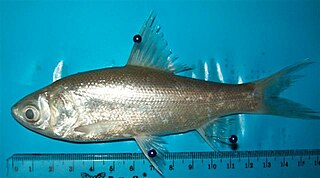
Mackerel is a common name applied to a number of different species of pelagic fish, mostly from the family Scombridae. They are found in both temperate and tropical seas, mostly living along the coast or offshore in the oceanic environment.

Herring are various species of forage fish, mostly belonging to the family Clupeidae.

The International Union for Conservation of Nature (IUCN) Red List of Threatened Species, also known as the IUCN Red List or Red Data Book, founded in 1964, is an inventory of the global conservation status and extinction risk of biological species. A series of Regional Red Lists, which assess the risk of extinction to species within a political management unit, are also produced by countries and organizations.

Mahseer is the common name used for the genera Tor, Neolissochilus, Naziritor and Parator in the family Cyprinidae (carps). The name is, however, more often restricted to members of the genus Tor. The range of these fish is from Vietnam in the east and China in the north, through Laos, Cambodia, Thailand, Malaysia, Brunei and Indonesia, and across southern Asia including the countries of India, Nepal, Bhutan and Bangladesh within the Indian Peninsula, plus Sri Lanka, Pakistan and Afghanistan. They are commercially important game fish, as well as highly esteemed food fish. Mahseer fetch high market price, and are potential candidate species for aquaculture. Several of the larger species have suffered severe declines, and are now considered threatened due to pollution, habitat loss, overfishing and increasing concern about the impacts of unregulated release of artificially bred stock of a very limited number of species.

Thunnus is a genus of ocean-dwelling, ray-finned bony fish from the mackerel family, Scombridae. More specifically, Thunnus is one of five genera which make up the tribe Thunnini – a tribe that is collectively known as the tunas. Also called the true tunas or real tunas, Thunnus consists of eight species of tuna, divided into two subgenera.

Rita gogra is a species of bagrid catfish endemic to India where it is found in the rivers of the Deccan Plateau up to the Krishna River system. It is an inhabitant of large rivers. It grows to a total length of 26 cm and is commercially fished for human consumption.

Sperata seenghala, the Giant river-catfish, is a species of bagrid catfish. It is known locally as Guizza, Guizza ayer, Auri, Ari, Pogal, Singhara and Seenghala, among other names. It is found in southern Asia in the countries of Afghanistan, Pakistan, India, Nepal and Bangladesh with reports of occurrence in Myanmar, Thailand and Yunnan, China. It can reach a length of 150 cm, though lengths up to 40 cm are more usual. It is commercially fished for human consumption as well as being a popular gamefish with a reputation for being a good fighter when hooked. It is carnivorous in diet. It can be distinguished from other Sperata species by its spatulate, blunt snout, relatively short barbels and mouth that is only 1/3 as wide as the head is long.
Bagarius bagarius, also known as the giant devil catfish or goonch, is a species of catfish in the genus Bagarius. It is generally reported as being found in large and medium rivers in South Asia, and is likely synonymous with B. yarrelli.

Gagata itchkeea is a species of sisorid catfish native to India and probably also to Pakistan. This species grows to a length of 7.6 centimetres (3.0 in) TL.

The Deccan white carp is a species of freshwater cyprinid fish native to Karnataka and Maharashtra in India initially but later to other states after the construction of dams. It is currently widely distributed across the states of Maharashtra, Karnataka, Telangana, Andhra Pradesh, Chhattisgarh, and Madhya Pradesh.

Nemachilichthys is a monospecific genus of freshwater ray-finned fish belonging to the family Nemacheilidae, the stone loaches. The only species in the genus is Nemachilichthys rueppelli, the mongoose loach or Shimoga loach, a species endemic to the Western Ghats in Karnataka and Maharashtra.

Opsarius is a genus of fish. Its representatives can be found in a variety of countries in South East Asia. These countries include Cambodia, Laos, Thailand, Myanmar, India, and China. Certain species of Opsarius are considered endemic to their respective habitats; such as Opsarius cocsa and Opsarius maculatus which are endemic to India.

Thynnichthys is a genus of freshwater ray-finned fish belonging to the family Cyprinidae, the family which also includes the carps, barbs, minnows and related fishes. The fishes in this genus are found in southern Asia from India to Borneo.

Tariqilabeo periyarensis is a species of fish in the family Cyprinidae. This species is only found in Periyar River in Kerala, India.

Thynnichthys thynnoides is a species of fish in the family Cyprinidae from mainland southeast Asia and the islands of Borneo and Sumatra.

The humpback mahseer is a species of freshwater ray-finned fish from the Indian endemic genus Hypselobarbus in the carp and minnow family Cyprinidae.
Thynnichthys polylepis is a species of cyprinid of the genus Thynnichthys. It inhabits Sumatra and Borneo. It has a maximum length among unsexed males of 18.0 centimetres (7.1 in). Described in 1860 by Pieter Bleeker, it is considered harmless to humans.
Thynnichthys vaillanti is a species of cyprinid of the genus Thynnichthys. It inhabits rivers in eastern Borneo. Described by Max Carl Wilhelm Weber and Lieven Ferdinand de Beaufort in 1916, it has a maximum length among unsexed males of 26.4 centimetres (10.4 in) and is considered harmless to humans.
















